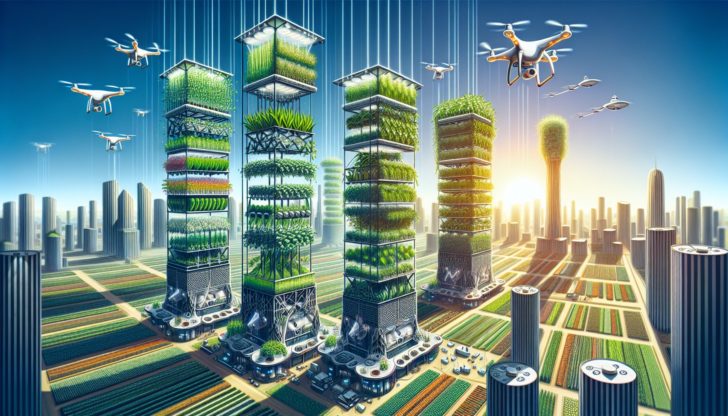Vertical farming is the practice of cultivating food in vertically stacked layers within controlled environments. As urban populations surge and arable land dwindles, this innovative method is essential for our future food supply. This article explores how vertical farming maximizes space and resources, providing fresh produce where conventional farming can’t.
Table of Contents
Key Takeaways
Vertical farming uses controlled indoor environments and advanced agricultural techniques like hydroponics, aeroponics, and aquaponics to improve space and resource efficiency, enabling higher yields with less land and water.
The approach provides several ecological and social benefits, such as reducing greenhouse gas emissions and water use, supplying fresh produce to urban areas, and increasing resilience against climate change.
While vertical farming faces challenges like high initial investments, energy costs, and the need for technological advancements, its future growth to a projected USD 23.23 billion industry by 2029 indicates its potential to significantly contribute to food security and sustainability.
Understanding Vertical Farming

Vertical farming is an agricultural process where crops are grown on top of each other in a controlled indoor environment. This method not only allows for an increase in productivity per acre by growing upward in stacked layers but also optimizes the available space for food production. The rise of vertical farms is a direct response to:
the increasing demand for food
the need for efficient use of resources
the desire to bring food production closer to consumers, thus minimizing transportation distances to consumption points.
Controlled Environment Agriculture (CEA), a key element of vertical farming systems, meticulously manages conditions such as temperature, light, and humidity to meet plant requirements. This control optimizes growth and yield, exhibiting the remarkable synergy of nature and technology in vertical farms.
Definition and Principles
Vertical farming, also known as vertical agriculture, is the practice of growing crops in vertically stacked layers, often within controlled environments that employ advanced cultivation techniques such as hydroponics, aquaponics, and aeroponics.
The term ‘vertical farming’ was first coined by Gilbert Ellis Bailey in 1915, but its modern incarnation is vastly different, referring to the practice of growing plants in layered setups within structures like buildings or warehouses.
Key Components
Sophisticated growing systems such as hydroponics, aeroponics, and aquaponics lie at the heart of vertical farms, facilitating soil-less plant cultivation. These systems administer a nutrient-rich solution to plants, enabling precise control over the growing conditions. LED grow lights are another pivotal component, offering energy efficiency and specific light spectra that are favorable for plant growth.
In addition to these growing systems, climate control managed by HVAC systems ensures the perfect environment for optimal plant development. The physical infrastructure, composed of tall, multi-layer shelving systems, is engineered to endure the strict conditions of a controlled warehouse climate. Advanced monitoring systems oversee plant health and high-quality drainage solutions uphold sanitary conditions, both fundamental for efficient vertical farming operations.
The Evolution of Vertical Farming Techniques

Vertical farming has evolved from the ancient terraced rice paddies of East Asia, an early example of utilizing vertical space in agriculture, to the modern, technologically driven practice that it is today. The 20th century saw the emergence of indoor cultivation concepts, paving the way for today’s vertical farming techniques. Dickson Despommier’s vision of growing food in vertically stacked layers, beginning in 1999, added significant momentum to the movement.
Technological advancements have been integral to the evolution of vertical farming. Methods like hydroponics, aeroponics, and aquaponics enable soil-less plant growth, while LED lighting and automation enhance efficiency. Data analytics for environmental control, closed-loop systems for sustainability, and commercial expansion into urban edifices are all part of the remarkable journey of vertical farming.
Comparing Vertical Farming to Traditional Farming
Vertical farming presents a stark contrast to traditional farming by enabling increased crop yields, decreasing land use, and offering a broader variety of crops that are not limited by seasonal constraints. It provides urban consumers with year-round access to fresh produce and caters to the growing demand for organic and residue-free food products.
While vertical farming offers numerous advantages related to sustainability and crop yield, it hasn’t yet reached the potential to entirely replace traditional farming in feeding the global population.
Space and Resource Efficiency
One of the most impressive aspects of vertical farming is its space and resource efficiency. By stacking multiple growing layers, vertical farms produce the equivalent of several acres of traditional farmland within a much smaller footprint. Water consumption is drastically reduced through precision hydroponic systems that deliver the exact amount of water needed, contributing to a significant reduction in water usage compared to traditional agriculture.
Another significant benefit of vertical farming is energy efficiency, achieved through advanced irrigation systems and energy-saving LED lighting that minimize the overall energy footprint of food production. IoT sensors, crucial in supervising water and nutrient levels, enhance these efficiencies and further diminish the environmental impact of food cultivation.
Crop Diversity and Production
Vertical farming holds immense potential to accommodate a broad range of crops. This technique fosters the growth of fresh produce frequently found in supermarkets, even including rare and heirloom varieties, thereby aiding in preserving genetic diversity. In terms of production rates, studies indicate that vertical farms yield on average 516 times as many tons of harvest per 10,000 square meters compared to traditional field farms. For certain crops like lettuce, vertical farms can produce nearly 8 times more per square foot than traditional farms, showcasing a significantly higher production rate.
Techniques such as crop rotation, companion planting, and pest management in vertical farms support the prevention of pest and disease buildup, which directly contributes to crop diversity and overall production health. These practices, combined with the controlled conditions of vertical farms, ensure a consistent and robust yield of a wide array of vegetables and greens.
The Role of Technology in Vertical Farming

Advancements in AI, IoT, robotics, and software, the driving forces behind vertical farming, significantly boost efficiency, productivity, and sustainability. Load cell and force sensors provide real-time data crucial for optimizing growing conditions, while energy-efficient LED lighting tailors specific growth conditions for various plant species, despite the associated high energy costs.
Controlled environment agriculture is fundamental in vertical farming, allowing environmental factors to be manipulated to optimize plant growth. This leads to accelerated growth cycles and increased production rates.
Continued technological advancements, including eden green technology, fortify the development and success of vertical farms, securing their position at the vanguard of agricultural innovation.
Vertical Farming’s Impact on Food Security and Sustainability
Vertical farming is making significant strides in supporting global food security by enabling the growth of food year-round and catering to the increasing population’s food demand. It is considered a sustainable alternative to traditional farming, with substantial benefits including:
Substantial water savings
Lower greenhouse gas emissions
Reduction of food waste, owing to the proximity of farms to consumers, which ensures fresher products and diminishes transportation-induced spoilage.
Local communities are empowered by vertical farming in the following ways:
It provides clean and nutritious food
It reduces a country’s dependence on food imports
Research in vertical farming is enhancing crop diversity, which is integral to fostering nutritional value and a resilient food system.
Urban Agriculture and Food Deserts
Serving a transformative role in urban agriculture, vertical farming supplies fresh produce in areas with scarce supermarket access, combating food deserts by repurposing underused urban spaces into flourishing sources of food. This not only improves access to healthy food options in underserved communities but also stimulates economic growth by creating jobs and encouraging community development.
Urban vertical farms, such as Vertical Harvest and urban hydroponic farms, illustrate the potential to supply local food all year round, create jobs, and engage with communities. As urban populations continue to grow, vertical farming offers a solution to self-reliance in food production, enhancing urban resilience against climate change effects and ensuring consistent food availability for city dwellers.
Climate Change Resilience
Vertical farming offers significant resilience against climate change, as indoor farming:
Provides controlled indoor environments that resist extreme weather events, ensuring stable food production
Utilizes advanced technologies that allow for optimal growth conditions
Reduces the environmental impacts of traditional agriculture through controlled resource use and less dependency on harmful chemicals
In regions with harsh climates, such as Svalbard, Norway, vertical farming demonstrates its capacity to grow crops year-round using renewable energy, even without natural sunlight, showcasing its viability and adaptability to various climate conditions.
Real-World Examples of Indoor Vertical Farming

Around the world, vertical farming is being put into practice with remarkable success. Bustanica, the world’s largest vertical farm near Dubai’s Al Maktoum International Airport, exemplifies the scale that vertical farming can achieve. With the capacity to produce one million kilograms of leafy greens annually, this farm showcases the commercial viability of vertical farming.
Other innovative examples include Sky Greens in Singapore, Growing Underground in London, and Pink Farms in Sao Paulo, Brazil. These operations demonstrate the adaptability of vertical farming to different urban settings and climates, providing locally grown produce and contributing to local food security.
Challenges and Limitations of Vertical Farming
Despite its potential, vertical farming encounters multiple challenges and limitations. Some of these challenges include:
Substantial initial investment and continual energy costs for lighting and climate control
Market demand fluctuations, which require maintaining competitive pricing against traditional agriculture
Regulatory compliance and production system optimization, which require continuous technological advancements
These challenges make it difficult for vertical farming to scale up and be widely adopted. However, with ongoing research and innovation, these obstacles can be overcome, and vertical farming can become a more sustainable and efficient method of food production.
The risk of rapid spread of water-borne diseases and pests within vertical farms necessitates vigilant monitoring and strict hygiene practices. However, there is cautious optimism that vertical farming can achieve profitability by embracing renewable energy and optimizing system efficiencies.
The Future of Vertical Farming

With a projected expansion from USD 14.23 billion in 2024 to USD 23.23 billion by 2029, the future of vertical farming looks promising. This growth signifies the escalating recognition of vertical farming’s capacity to tackle food security challenges for the world’s population and its contribution to sustainable agriculture.
As technology continues to advance and cost-effectiveness improves, vertical farms are expected to become an increasingly common feature in urban areas, contributing to a more sustainable and resilient food system.
Learn more, visit Vertical Farming: The Future of Growing Up.
Summary
Vertical farming represents an innovative leap in food production, offering a sustainable, efficient, and resilient approach to feeding the growing global population. With its ability to produce a diverse array of crops year-round, reduce environmental impacts, and empower local communities, vertical farming stands as a promising solution to many of the challenges faced by traditional agriculture. As we look to the future, vertical farming not only inspires hope for a greener, more food-secure world but also challenges us to rethink the very nature of farming itself.
Frequently Asked Questions
Why don’t we use vertical farming?
Vertical farming is not widely used due to the high cost of setting up and maintaining a vertical farm, as it requires specialized and expensive equipment. Consider the financial investment before deciding to pursue vertical farming.
What are the disadvantages of vertical farming?
Vertical farming has the disadvantages of high initial costs, requiring specialized equipment, being energy intensive, and having limited crop variety. These factors can make vertical farming challenging to implement and sustain.
Is vertical farming profitable?
Yes, vertical farming can be profitable with recent technological advancements helping to overcome challenges like high energy prices and labor costs. Vertical farming has the potential for higher yields, fewer inputs, and less waste, but it is still struggling to reach profitability.
What is vertical farming?
Vertical farming is the practice of growing crops in vertically stacked layers within controlled environments, using advanced cultivation techniques to optimize space and resources for food production. It includes methods like hydroponics, aquaponics, and aeroponics.
How does vertical farming compare to traditional farming in terms of space and resource efficiency?
Vertical farming is much more space and resource-efficient than traditional farming, as it can produce the same output as several acres of farmland in a smaller area and reduces water consumption by up to 98% through precise hydroponic systems.









